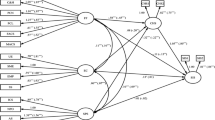Abstract
This study tests both the stress/social support and the stress/problem-solving etiological models for suicidality while controlling for depression. To this end, a depressed, high-suicide-ideating sample (N=68) was compared to a depressed, low-suicide-ideating sample (N=64). Hierarchical multiple regression analyses were used to test the unique contributions of stress, problem-solving orientation, problem-solving skills, and perceived level of social support in predicting level of suicidality. Hierarchical regression analyses were also used to test the interactive contributions of problem-solving × stress and social support × stress in predicting level of suicidality. Regression models were generated separately for men, women, and the entire sample using all factors. The results clearly support the importance of social support as an independent predictor of suicidality for men, women, and the entire sample. Ability to generate alternatives to identified problems predicted suicidality, but only for women and the entire sample. Problem-solving orientation was not uniquely predictive of suicidality and may affect suicidal behavior via its relationship to depression.
Similar content being viewed by others
References
Beck, A., Kovacs, M., & Weissman, A. (1979). Assessment of suicidal ideation: The Scale for Suicide Ideators.Journal of Consulting and Clinical Psychology, 47, 343–352.
Bonner, R. L., & Rich, A. R. (1987). Toward a predictive model of suicide ideation and behavior: Some preliminary data in college students.Suicide and Life-Threatening Behavior, 17, 50–63.
Bonner, R. L., & Rich, A. (1988). Negative life stress, social problem-solving self-appraisal, and hopelessness: Implications for suicide research.Cognitive Therapy and Research, 12, 549–556.
Braucht, G. N. (1979). Interactional analysis of suicidal behavior.Journal of Consulting and Clinical Psychology, 47, 653–669.
Clum, G. A. (1992).Manual for the Personal Problem-Solving Evaluation (PPSE), Unpublished manuscript. Blacksburg, VA: Virginia Polytechnic Institute and State University.
Clum, G. A., & Febbraro, G. A. R. (1994). Stress, social support, and problem-solving appraisal/skills: Prediction of suicide severity within a college sample.Journal of Psychopathology and Behavioral Assessment, 16, 69–83.
Clum, G. A., & Yang, B. (1995). Additional support for the reliability and validity of the Modified Scale for Suicide Ideation.Psychological Assessment, 7, 122–125.
Clum, G. A., Patsiokas, A. T., & Luscomb, R. L. (1979). Empirically based comprehensive treatment program for parasuicide.Journal of Consulting and Clinical Psychology, 47, 937–945.
D'Attilio, J. P., Campbell, B. M., Lubold, P., Jacobson, T., & Richardson, J. A. (1992). Social support and suicide potential: Preliminary findings for adolescent populations.Psychological Reports, 70, 76–78.
D'Zurilla, T., & Goldfried, M. (1971). Problem-solving and behavior modification.Journal of Abnormal Psychology, 78, 107–126.
Heppner, P. P., and Petersen, E. H. (1982). The development and implications of a personal problem-solving inventory.Journal of Counseling Psychology, 29, 66–75.
Miller, I. W., Norman, W. H., Bishop, S. B., & Dow, M. G. (1986). The Modified Scale for Suicidal Ideation: Reliability and validity.Journal of Consulting and Clinical Psychology, 5, 724–725.
Nezu, A. M., & Ronan, G. F. (1988). Social problem-solving as a moderator of stress-related depressive symptoms: A prospective analysis.Journal of Counseling Psychology, 35, 134–138.
Paykel, E., Prusoff, B., & Myers, J. (1975). Suicide attempts and recent life events.Archives of General Psychiatry, 32, 327–333.
Platt, J., & Spivack, G. (1975).Manual for the Means-End Problem-Solving Procedures (MEPS): A measure of interpersonal problem-solving skill. Philadelphia: Philadelphia Hanemann Community Health/Mental Retardation Center.
Priester, M. J., & Clum, G. A. (1993). The problem-solving diathesis in depression, hopelessness, and suicide ideation: A longitudinal analysis.Journal of Psychopathology and Behavioral Assessment, 15, 239–254.
Rich, A. R., & Bonner, R. L. (1987). Interpersonal moderators of depression among college students.Journal of College Student Personnel, 28, 337–342.
Rudd, M. D. (1990). An integrative model of suicidal ideation.Suicide and Life-Threatening Behavior, 20, 17–30.
Russell, D., Peplau, L. A., & Ferguson, M. L. (1978). Developing a measure of loneliness.Journal of Personality Assessment, 42, 290–294.
Russell, D., Peplau, L. A., & Cutrona, C. E. (1980). The Revised UCLA Loneliness Scale: Concurrent and discriminant validity evidence.Journal of Personality and Social Psychology, 39, 472–480.
Sadowski, C., & Kelley, M. L. (1993). Social problem solving in suicidal adolescents.Journal of Consulting and Clinical Psychology, 61, 121–127.
Sarason, I., Johnson, J., & Siegel, J. (1978). Assessing the impact of life changes: Development of the Life Experiences Survey.Journal of Consulting and Clinical Psychology, 46, 932–946.
Schotte, D. E., & Clum, G. A. (1982). Suicide ideation in a college population: A test of a model.Journal of Consulting and Clinical Psychology, 50, 690–696.
Schotte, D. E., & Clum, G. A. (1987). Problem-solving skills in suicidal psychiatric patients.Journal of Consulting and Clinical Psychology, 55, 49–54.
Schotte, D. E., Cools, J., & Payvar, S. (1990). Problem-solving deficits in suicidal patients: Trait vulnerability or state phenomenon?Journal of Consulting and Clinical Psychology, 58, 562–564.
Vaux, A. (1988). Undesirable life events and depression: The role of event appraisals and social support.Journal of Social and Clinical Psychology, 7, 290–296.
Yang, B., & Clum, G. A. (1994). Life stress, social support, and problem-solving skills predictive of depressive symptoms, hopelessness, and suicidal ideation in an Asian student population.Suicide and Life-Threatening Behavior, 24, 127–139.
Zung, W. (1965). A self-rating depression scale.Archives of General Psychiatry, 12, 63–70.
Author information
Authors and Affiliations
Rights and permissions
About this article
Cite this article
Clum, G.A., Canfield, D., Van Arsdel, M. et al. An expanded etiological model for suicide behavior in adolescents: Evidence for its specificity relative to depression. J Psychopathol Behav Assess 19, 207–222 (1997). https://doi.org/10.1007/BF02229179
Accepted:
Issue Date:
DOI: https://doi.org/10.1007/BF02229179




